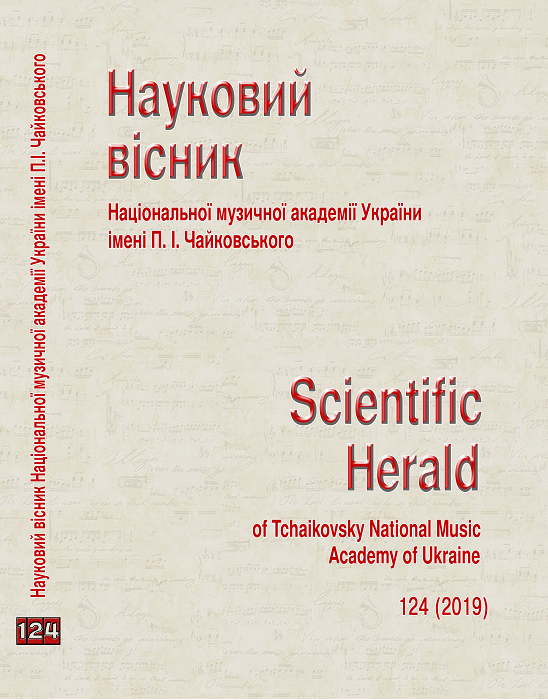Dialogue of epochs in music thinking of Arvo Pärt: “Credo”
DOI:
https://doi.org/10.31318/2522-4190.2019.124.165406Keywords:
Arvo Pärt’s works, J. S. Bach's music heirloom, hermeneutics, semantic analysis, Prelude in С Major, collageAbstract
Relevance of the study. One of the most important functions of musicological research is to indicate those tendencies in music which define the mainstream of the epoch, reflect its pulse. The necessity of this capacity becomes more and more vital when it comes to the analysis of the problems of contemporary art. Getting over the period of atheism, return to spirituality and seeking for God is characteristic of the pro-European culture of the second half of the 20th century. The tendency is represented by respective essential topics of the art discourse that form music mentality. One of these most substantial aspects is the significance of Johann Sebastian Bach's works for a contemporary listener. According to this important tendency, the central attention in the article has been focused on one of the works of Arvo Pärt, the famous Estonian composer, for whom the phenomenon of Bach’s music is rather valuable. The author represents Bach theme in the shape of a dialogue of the past and the present.
Main objective of the study is to accomplish a detailed analysis of different semantic levels of Arvo Pärt’s «Credo» (1968), written for a symphony orchestra, a mixed choir and a piano, so as to explain its close connection with the main cultural and music tendencies of the last half of the 20th century.
Methodology. The key methodological instrument of the research proposed is hermeneutics. In this context a concept of the work, its genre indications and the peculiarities of musical language have been carefully examined. J. S. Bach’s 1st Prelude in ’c’ major from the first volume of «The well-tempered clavier», literally quoted in the «Credo» by the composer, has been analysed separately for the purpose to clarify the author's inner motivation of using it in the work.
Results and conclusions. The accomplished study enables to derive the following conclusion: according to the results of the multi-level hermeneutic analysis, Arvo Pärt’s «Credo» should be classified as a typical and characteristic musical phenomenon of the last half of the 20thcentury.
Downloads
References
Sigov, K. and Finberg, L. (Ed.) (2014). Arvo Pärt: conversations, research, reflection [Arvo Pjart: besedy, issledovanija, razmyshlenija]. Kyiv: Dukh i litera, 218 p. [in Russian].
Berchenko, R. (2005). Searching for the lost sense. Boleslav Javorsky’s comments for «Well Tempered Clavier» [V poiskah utrachennogo smysla. Boleslav Javorskij o «Horosho temperirovannom klavire»]. Мoscow: Izdatel’skij dom «Klassika–XXI», 372 р. [in Russian].
Volkonskij, A. (1998). Basics of temperation [Osnovy temperatsii]. Мoscow: Kompozitor, 92 р. [In Russian].
Grachjov, V. «New simplicity» and minimalism – style tendencies in contemporary art (on A. Pärt’s and V. Martynov's works as illustrative material [«Novaja prostota» i minimalizm – stilevye tendencii v sovremennom iskusstve (na primere tvorchestva A. Pjarta i V. Martynova)]. Available at: http://harmony.musigi-dunya.az/RUS/archivereader.asp?s=1&txtid=528 (Accessed 16 Feb. 2019) [in Russian].
Kolganova, O. V. (2010). Solar interpretations in academic music of the 20th century (K. Penderetsky’s «Cosmogony») [Soljarnye interpretacii v akademicheskoj muzyke XX v. («Kosmogonija» K. Pendereckogo)]. Vremennik Zubovsky Institute [Vremennik Zubovskogo instituta], Issue 4: Grani interpretatsii, pp. 16–27 [in Russian].
Kuznecova, M. V. (2007). Meditativity as a quality of music thinking: Avet Terteryan, Arvo Pärt, Valentine Silvestrov [Meditativnost’ kak svojstvo muzykal’nogo myshlenija: Avet Terterjan, Arvo Pjart, Valentin Sil’vestrov]. Diss ...Cand. Degree of Ph.D in History of Arts : 17.00.02 – Musical Arts. Мoscow, 233 p. [in Russian].
Oseckaja, О. V. (2008). Sacred word in Pärt’s music [Svjashhennoe slovo v muzyke A. Pjarta]. Diss ...Cand. Degree of Ph.D in History of Arts : 17.00.02 – Musical Arts. Nizhnij Novgorod, 167 p. [in Russian].
Savenko, S. Arvo Pärt: strokes to jubilee portrait [Arvo Pjart: shtrihi k jubilejnomu portretu]. Available at: http://spiegelimspiegel.ru/bio/testimonials/arvo-part-savenko/ (Accessed 11 Oct. 2018) [in Russian].
Тоkun, E. А. (2009). Arvo Pärt. Tintinnabuli: technique and style [Arvo Pjart. Tintinnabuli: tehnika i stil’]. Diss ...Cand. Degree of Ph.D in History of Arts : 17.00.02 – Musical Arts. Moscow, 272 p. [in Russian].
Shnitke, A. (1994). Polystylistic tendencies of modern music [Polistilisticheskie tendencii sovremennoj muzyki: Besedy s Al’fredom Shnitke]. Moscow: RIK «Kul’tura», pp. 143-146 [in Russian].
Shvejcer, А. (1965). Johann Sebastian Bach [Iogann Sebast’jan Bah]. Мoscow: «Muzyka», 728 p. [in Russian].
Gröhn, C. (2006). Dieter Schnebel and Arvo Pärt: composers as «theologians» [Dieter Schnebel und Arvo Pärt: Komponisten als «Theologen»]. Münster, 256 p. [in German].
Hillier, P. (1997). Arvo Pärt. Oxford, 232 р. [in English].
Lubow, A. (2010). The sound of spirit. The New York Times. October, 15. Avaliable at: https://archive.nytimes.com/www.nytimes.com/2010/10/17/magazine/17part-t.html (Accessed 24 Oct. 2018) [in English].
Downloads
Published
How to Cite
Issue
Section
License
Our journal abides by the CREATIVE COMMONS copyright rights and permissions for open access journals.
Authors, who are published in this journal, agree to the following conditions:
The authors reserve the right to authorship of the work and pass the first publication right of this work to the journal under the terms of a Creative Commons Attribution License, which allows others to freely distribute the published research with the obligatory reference to the authors of the original work and the first publication of the work in this journal.
The authors have the right to conclude separate supplement agreements that relate to non-exclusive work distribution in the form in which it has been published by the journal (for example, to upload the work to the online storage of the journal or publish it as part of a monograph), provided that the reference to the first publication of the work in this journal is included.




